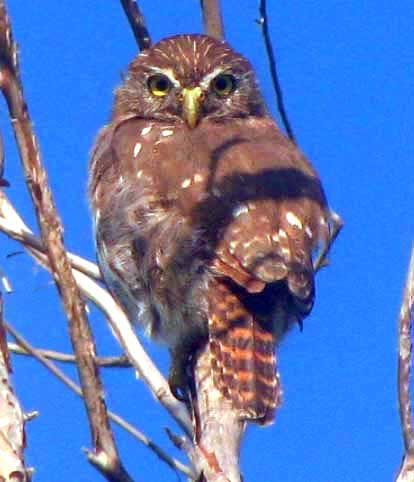Excerpts from Jim Conrad's Naturalist Newsletter
from the November 10, 2008 Newsletter written in Yokdzonot, Yucatán, México
FERRUGINOUS PYGMY-OWL
Wednesday morning along the road to Mexil one perched on a limb beside the road in plain view about 30 feet away, allowing the photo shown below:

In western North America the closely related Pygmy Owl, belonging to the same genus Glaucidium, is very similar. Both owls are surprisingly aggressive for their size, are often diurnal (appear during the day) have longish tails and two black, white-outlined patches on their back necks resembling eyes when the bird is seen from behind. They differ in the Ferruginous being more reddish and having different tail barring, and in their hooting.
Easterners may not have a feeling for how small an owl should be to be considered a pygmy. The Ferruginous is about 7 inches long (18 cm), which makes it smaller than the 8.5-inch American Robin, and only a third the length of the 21-inch Great Horned Owl.
Ferruginous Pygmy-Owls are distributed from southern Texas and the US desert Southwest to Argentina.
from the September 18, 2011 Newsletter issued from Mayan Beach Garden Inn 20 kms north of Mahahual; Caribbean coastal beach and mangroves, ~N18.89°, ~W87.64°, Quintana Roo state, MÉXICO
PYGMY-OWLS HERE, TOO
In Querétaro and Chiapas we saw that Ferruginous Pygmy-Owls were common, and at Chichén Itzá they were abundant, calling with their monotonous weep-weep-weeps almost to the point of botheration. We have them here, too, weep-weeping from beside the mangroves, though not as prodigiously as at Chichén Itzá. There's one looking over his shoulder at us below:
